More of Georgetown, Gt. Exuma and Conception
18th March - 12th April 2005
After this, we decided it would be safer to carry out the necessary work on the engine whilst "safely tied up" in the marina in Georgetown, rather than at anchor, in case the weather should turn bad whilst our engine was disabled. Our only concern was the depth of water at the marina docks but the dock master assured us they all had a minimum depth of seven feet at low tide. We proved them wrong and spent an unpleasant few hours during the first low tide when the six and a half foot keel of our boat was banging and later resting on the sea bed. So, our first day was frustrating, we were unable to start work and spent several hours waiting for the tide to get high enough for us to relocate to a deeper dock, which we were sure to sound out for ourselves with our trusty lead line. At least this meant that before we dismantled our engine, we knew the new gaskets had arrived safely in the Georgetown by plane, in the excellent care of Second Chance's guest Barbara Banus. Unfortunately her own luggage wasn't so lucky!
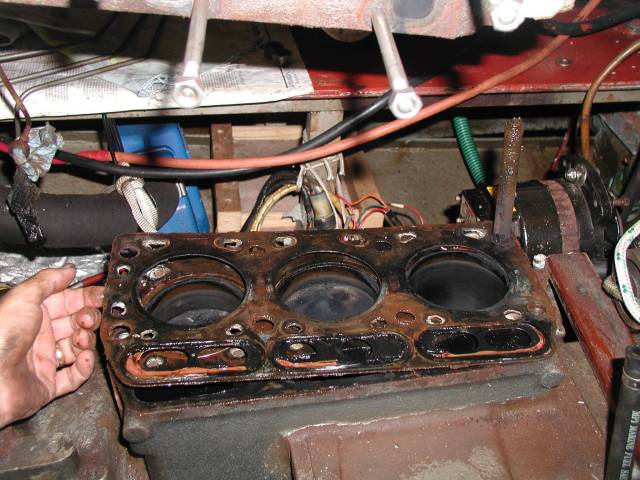
Taking out the old head gasket.
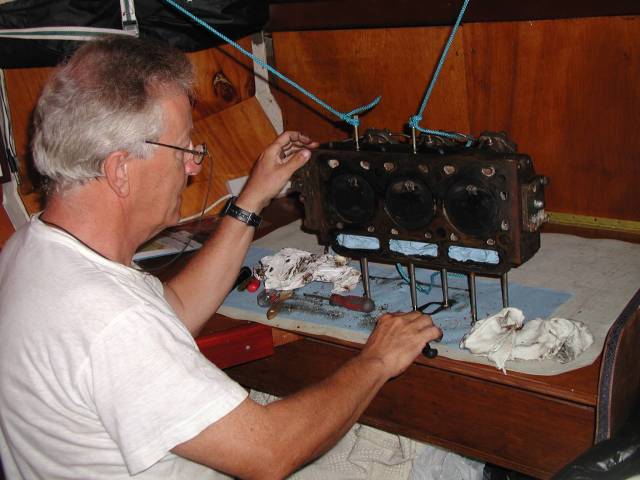
Cleaning off the cylinder head
After spending a couple of hours refitting the cylinder head, making sure everything was aligned and that the bolts were tightened to the correct torque, one of the valve push rods managed to fall inside the body of the engine with a loud crack. This led to much gnashing of teeth by the head chief mechanic Phil, who feared that all the afternoon's work would have to be undone to retrieve the errant push rod, which may well have snapped, just to add to our fun. Luckily, a very determined mechanic's apprentice managed to retrieve the undamaged push rod with a pair of long nosed pliers and at this point it was decided we should stop work for the day!
The reassembly was finished and tappets set the next morning. Chris came by to advise us about bleeding the injectors by cranking over the engine. Finally we were ready to put our work to the test and were amazed when we turned the key and our trusty engine, Yanny, started first time and sounded fine.
As a reward for all our hard work, we treated ourselves to lunch at a local church fund-raiser in Williamstown, about 18 miles away. After being cramped in the hot engine room for two days, we found ourselves cramped with seventy other cruisers in a school bus the church had laid on to ferry in their customers! From the extensive menu, a local recommended the conch and mutton, which were both extremely fresh, judging by the sheep skins and conch shells lying nearby!
Back at anchor after our hard work, our traumas were not over! Yet another cold front passed over at 5 am one morning, causing a 180 degree wind shift. As Anju swung around on her anchor, our trusty anchor drag alarm raised us from our beds. As always, we had set the alarm distance such that if we did swing right around, we would be awoken to check that everything was fine in our new position. On this occasion it proved to be worth the many times we'd got up unnecessarily, as we found ourselves lying only a few feet from the bow of the next boat. By the time we'd started the motor and started hauling up our anchor chain, we were right alongside our neighbour with a clearance of only a foot or two between us, it was a miracle Anju hadn't collided with them.
We quickly raised our anchor and picked out another spot, which wasn't easy between the anchored boats in the pitch dark. We couldn't understand what had happened, we hadn't dragged but ended up right on top of the other boat. It was only later when Phil went over to tell our neighbours what had happened, that we discovered the other boat had laid out two anchors from their bow, 180 degrees apart. This would be great if you needed to reduce your swinging area in a limited space but causes chaos if every other boat in the anchorage is swinging on one anchor, as you would move differently. Despite us firing up our engine two feet from their boat at 5 am, they had remarkably slept right through the whole drama. We hadn't noticed their second anchor when we'd come into the anchorage and resolved always to check more carefully for nearby boats anchored with two anchors, even in places where it would seem unnecessary and unusual.
After our enforced stay in Georgetown, we decided it was time for some more adventures and headed out to Conception Island, a nature reserve, where we were reunited with Chris and Vivian on 2nd Chance. Their luck with fishing had been better than ours but they were disappointed to only catch a tuna, which they planned to give away. We quickly dissuaded them from this idea, offering to prepare it for them. Phil filleted the tuna and threw the carcass overboard to be quickly devoured first by a large stingray, which was soon chased away by a large black tip reef shark. At this point we decided to cancel our planned snorkelling trip and were then astounded when the shark was driven off its dinner by an enormous barracuda! After sampling their own catch grilled by Phil, Chris and Vivian decided that no more tuna would ever be given away to their friends! Our next meal was almost dog steak, when their mischievous Portuguese Water Dog, Zapper, stole one of the remaining tuna loins when our backs were turned!
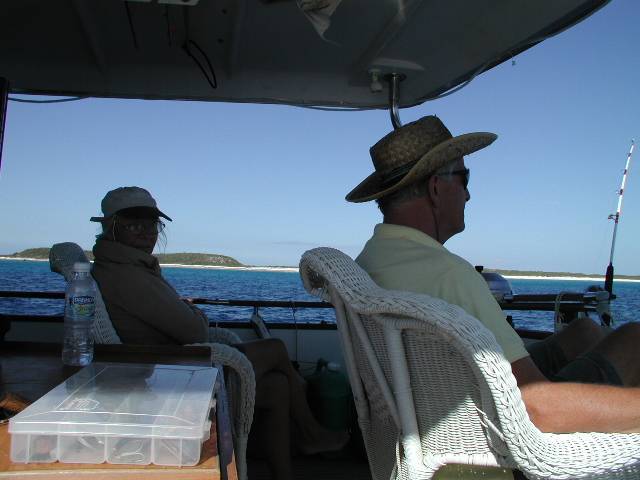
Vivian and Phil waiting patiently for a bite, whilst
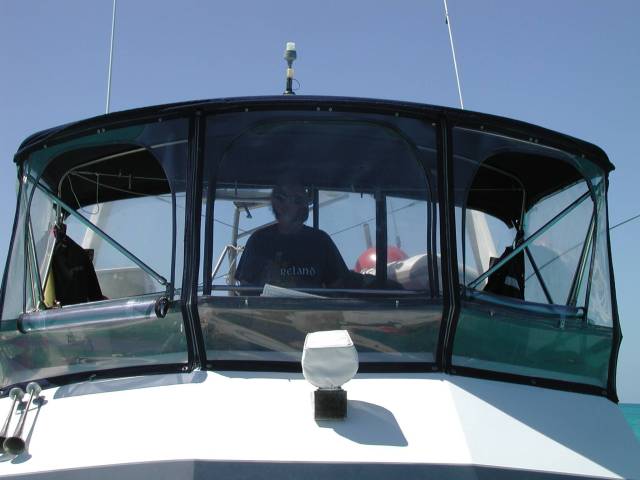
Chris, on the fly-bridge, searches for signs of fish
Keen for more meals of fresh fish, we arranged a fishing trip the next day aboard 2nd Chance, which would cover more distance than Anju being a motor boat. After searching unsuccessfully for fish all morning, our enthusiasm waned and we decided to make a lunch stop in the bay on the opposite side of the uninhabited island. The eastern shore of the island proved to be as attractive as the western side, except that somebody had abandoned a huge, derelict drilling ship right there in paradise.
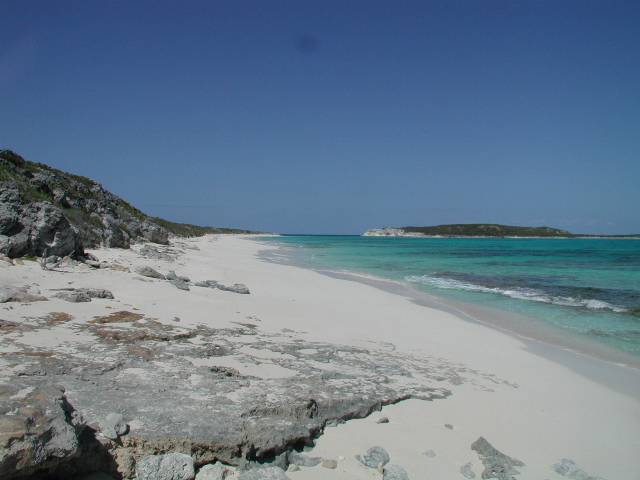
Uninhabited Conception, almost paradise.......
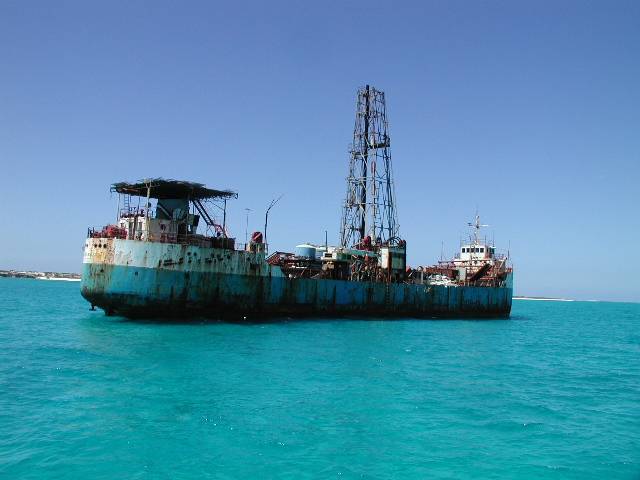
........but who left that there?
Despite the fishing trip being unproductive, it had whetted our appetites to see more of Conception, so we took a trip next day in their jet boat to explore the mangrove swamps, which make up most of the interior of the island. The shallow water was packed with conch and we also spotted many turtles swimming around.
It was time then to head to the beach for a spot of treasure hunting. Chris spotted some large red fenders lying washed-up on the beach and assigned Phil the task of diving off the jet boat, swimming ashore and retrieving them. We then set up our picnic after carrying everything ashore through the surf from the anchored boat. We even found an intact plastic chair which had washed ashore, so somebody could eat in comfort!
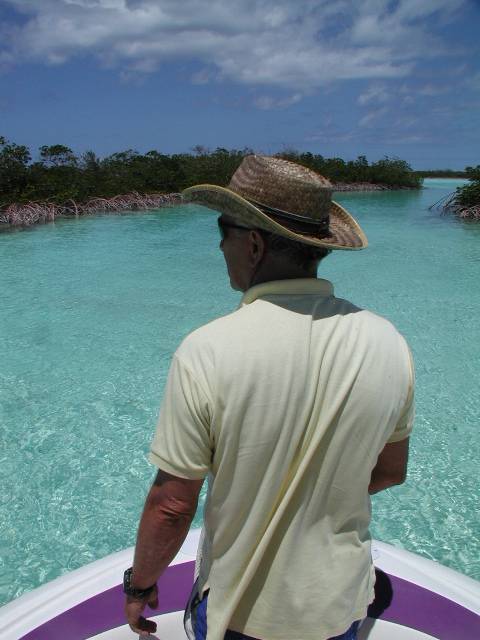
Piloting the jet boat through the shallow mangrove swamps.
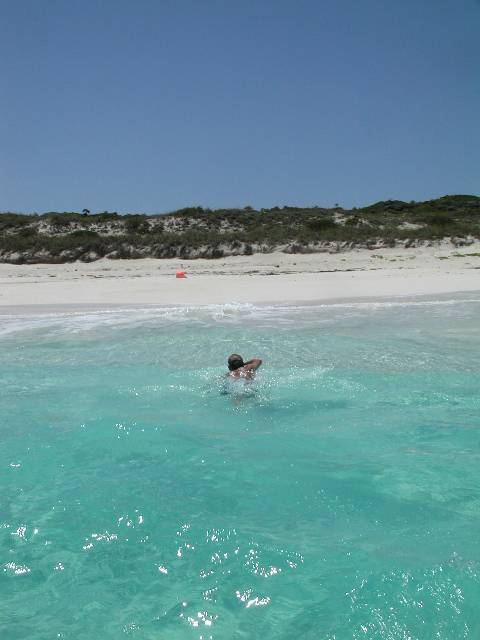
Phil, the fearless fender hunter!
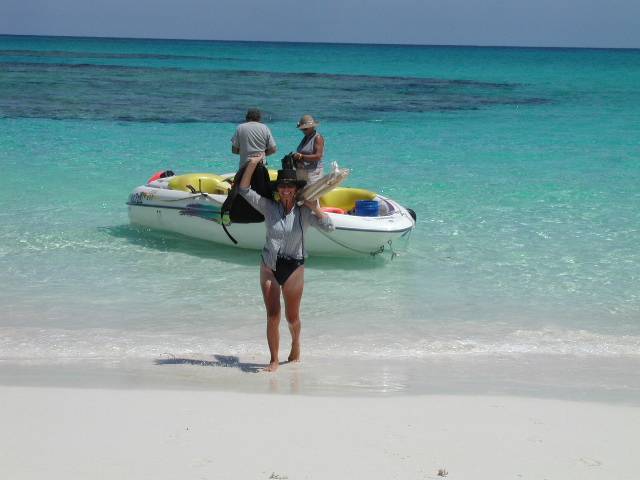
Preparing for the beach picnic
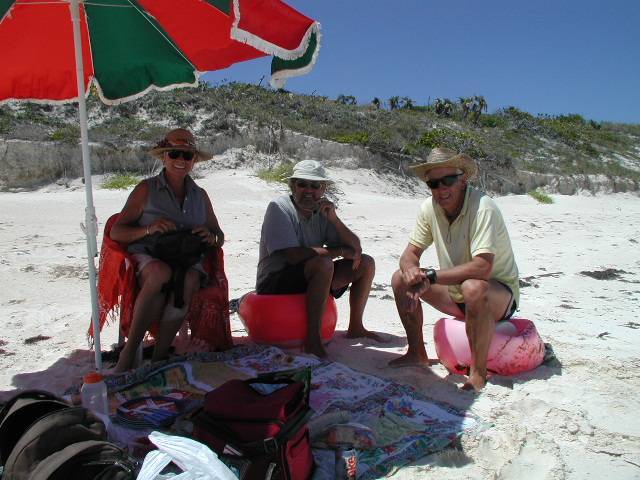
Vivian, Chris and Phil enjoy the picnic
It was a shame that another cold front was forecast, forcing us to leave the exposed anchorage at Conception the next day.